Conditionally edible milk mushrooms: photo and description of what black, oak, pepper and blue milk mushrooms look like
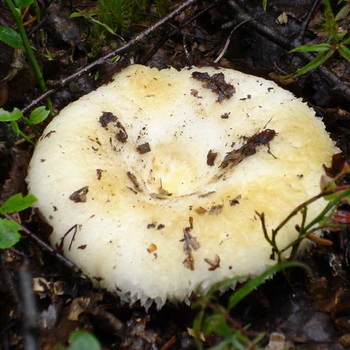 Milk mushrooms are widespread in Russia. Most often they can be found in the Urals and Siberia. Westerners believe that these mushrooms should not be eaten, but they are wrong. In fact, milk mushrooms are conditionally edible mushrooms, just the process of their preparation involves a lot of trouble.
Milk mushrooms are widespread in Russia. Most often they can be found in the Urals and Siberia. Westerners believe that these mushrooms should not be eaten, but they are wrong. In fact, milk mushrooms are conditionally edible mushrooms, just the process of their preparation involves a lot of trouble.
Below you can find a photo and description of black mushrooms and other types of these mushrooms: oak, pepper and blue mushrooms.
Conditionally edible oak lump
Category: conditionally edible.
Oak Burger Hat (Lactarius quietus) (diameter 3-9 cm): brown or reddish, usually almost flat in young mushrooms, becoming convex over time. The edges of the cap are sometimes curled towards the inside. Dry to the touch.
Leg (height 3-7 cm): solid, in old mushrooms it is almost always hollow, cylindrical in shape. It does not differ in color from the cap, except that it is darker near the ground.
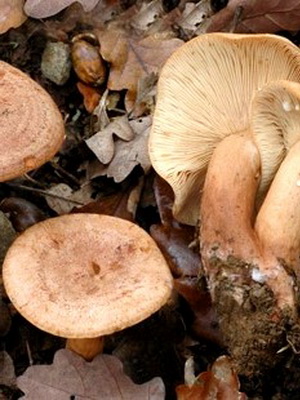
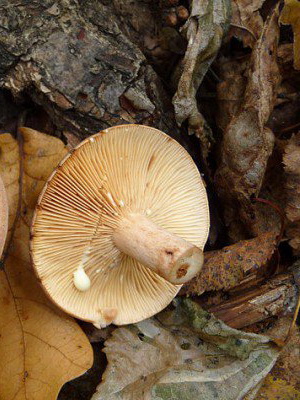
Pay attention to the photo of an oak mushroom: its plates are frequent and narrow, very thin.
Pulp: fragile, white, turns pink at the cut site. When cut or broken, it emits a pleasant scent of fresh hay.
Doubles: serushka (Lactarius flexuosus) and watery-milky milkweed (Lactarius serifluus). But the hat of the serushka has a grayish tinge, and the lacquer has a pungent odor and the hat is much darker.
When it grows: from mid-July to late September in the northern half of Europe.
Where can I find: in mixed and deciduous forests, most often next to oak trees, as the name implies.
Eating: suitable only for salting due to its low taste.
Application in traditional medicine (data not confirmed and not passed clinical trials!): in the treatment of urolithiasis.
Other names: the lactician is neutral, the lactician is oak, the lactician is calm.
Black milk mushroom: photo and description
Category: conditionally edible.
How it looks black lump (Lactarius necator), you can get an idea by looking at the photo:
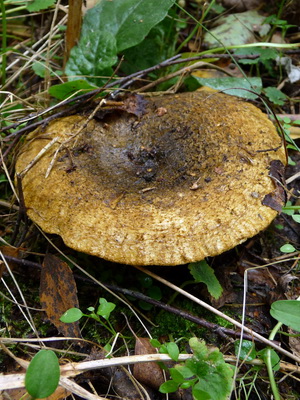
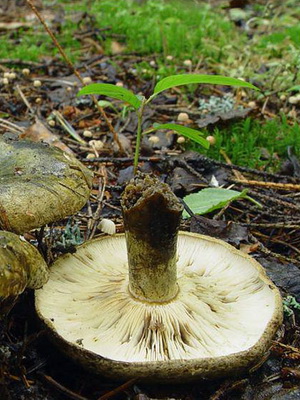
Hat (diameter 6-22 cm): dark brown or dark olive, usually flat, with a small depression in the center, but may also be funnel-shaped. The edges of the cap are usually bent towards the inside. In dry weather it is dry and smooth to the touch, in wet weather it becomes sticky and sticky.
Leg (height 4-10 cm): usually the same color as the cap, less often lighter. Expands upward, covered with mucus. In young mushrooms it is solid, in old it becomes almost hollow.
Plates: frequent and thin, descending to the peduncle.
Pulp: brittle, white, which turns gray when cut and when exposed to air. Produces a pleasant mushroom aroma.
Doubles: absent, black mushroom according to the description does not have any similar species.
When it grows: from early July to mid-October in temperate countries of the Eurasian continent.
Eating: after thorough soaking (at least 40 hours), boiling and peeling, the mushroom is very tasty when salted. Black milk mushrooms salted in jars can retain high taste for up to three years. It takes a long time to cook to remove the bitterness.
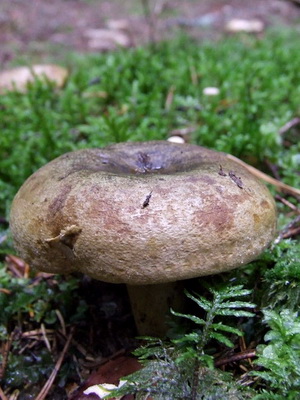
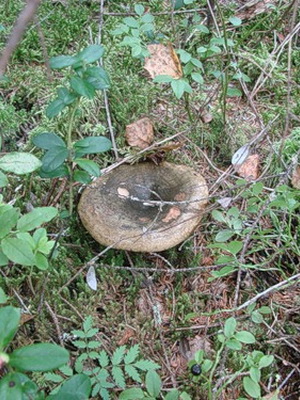
Black mushrooms can be found in bright corners of deciduous and mixed forests, often next to birch trees on uneven soil (potholes, hills and holes).
Often a black lump hides in moss or grass under fallen leaves.
Application in folk medicine (data have not been confirmed and have not undergone clinical trials!): As an antibacterial agent, in particular with difficult flowing sore throat.
Important! Do not be alarmed if black milk mushrooms turn bright purple, cherry or red after heat treatment. This is a common property of these mushrooms.
Other names: olive black lump, nigella, black nest, black nest, gypsy, black spruce breast, olive brown milk, boiled.
Milk camphor - conditionally edible mushroom
Category: conditionally edible.
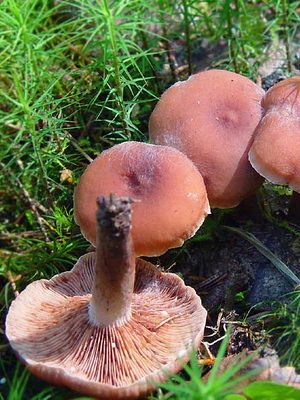
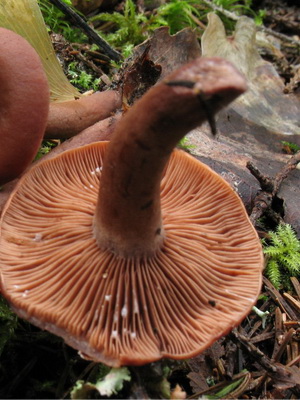
Camphor cap (Lactarius camphoratus) (diameter 4-8 cm): matte, usually brown or reddish. In young mushrooms, it is flat, with time it becomes concave. Smooth to the touch.
Leg (height 3-7 cm): fragile, cylindrical and usually the same color as the cap. Expands from bottom to top. In young mushrooms it is solid, in old ones it is hollow.
Plates: frequent, light pink. Older mushrooms can be almost brown.
Pulp: the same color as the outer surface. It emits a characteristic smell of camphor or crushed bedbugs, for which the mushroom got its name.
Doubles: absent (due to the characteristic odor).
When it grows: from the beginning of August to the end of September in the countries of the Eurasian continent with a temperate climate.
Where can I find: on the acidic soil of coniferous and deciduous forests.
Eating: under the condition of a long preliminary soaking, in order to remove a specific smell, you can eat it salty.
Application in traditional medicine (data not confirmed and not passed clinical trials!): it is believed that a decoction of camphor milk can help with fever and severe headaches.
Other names: lactic camphor.
Pepper milk: photo and description
Category: conditionally edible.
Pepper cap (Lactarius piperatus) (diameter 5-20 cm): usually white, very rarely light cream in color, which is more concentrated in the center and much lighter at the edges. In young mushrooms, it is rounded, later becomes almost horizontal, and then it is pronounced funnel-shaped. The edges are bent towards the inner side, but then straighten and become wavy. Smooth and pleasantly velvety to the touch.
Leg (height 3-10 cm): lighter than the cap, dense and solid, expanding from bottom to top. Smooth to the touch, may be slightly wrinkled.
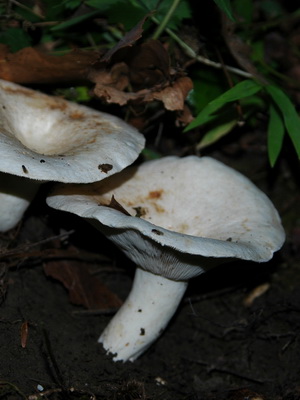
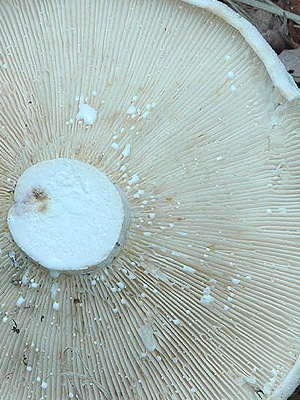
As you can see in the photo, the pepper mushroom has frequent, smoothly descending to the leg of the plate.
Pulp: white and very brittle, very pungent in taste. The milky juice is thick and acrid, has a white color that does not change over time.
Doubles:parchment milk mushrooms (Lactarius pergamenus) and glaucous (Lactarius glaucescens), violin (Lactarius vellereus). The parchment mass has a longer stem and characteristic wrinkles on the cap. The milky juice of the bluish color becomes greenish when it dries. And the violinist has a light fluff on the hat.
When it grows: from early July to mid-October in the countries of northern Eurasia.
Where can I find: in wet and clayey places of mixed and deciduous forests.
Eating: can be salted after careful heat treatment. Thanks to its pungent taste, powdered dried mushroom can be a worthy substitute for black pepper.
Application in traditional medicine (data not confirmed and not passed clinical trials!): fried - as a reliable remedy in the treatment of kidney stones. In addition, scientists were able to isolate a substance from the pepper mushroom that kills tubercle bacilli.
Blue milk mushroom and its photo
Category: conditionally edible.
Hat of a blue breast (Lactarius repraesentaneus) (diameter 5-15 cm): usually yellow in color, which turns purple or blue at the place of pressure, which is why the mushroom got its name. In young mushrooms, it is slightly convex, over time it changes to a more open or slightly depressed. The pubescent edges are bent towards the inner side. Mucous to the touch in wet weather.
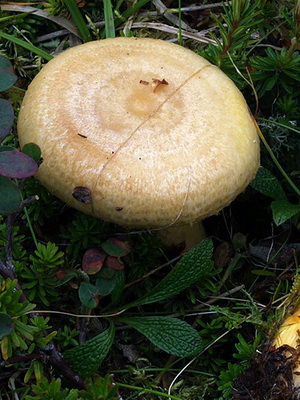
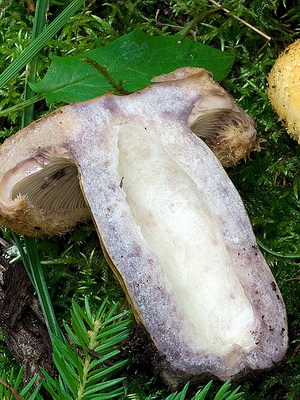
As you can see in the photo of a blue mushroom, the mushroom has a yellow leg 5-9 cm high, slightly lighter than the cap, cylindrical, often hollow.
Plates: narrow, medium frequency, lemon or yellow in color, which darkens with pressure.
Pulp: thick and dense, cream, light brown or yellow in color. With white milky juice, which turns purple when it interacts with air.
Doubles: absent.
When it grows: from mid-August to early October.
Where can I find: in coniferous and mixed forests, often next to spruce and birch trees.
Eating: not pickled, as not only the mushrooms turn blue, but also the liquid. In cooking, it is used boiled or fried.
Application in traditional medicine: does not apply.
Other names: a blue lump of yellow, a purple lump, a lilac golden yellow, a dog's lump.
Conditionally edible aromatic lump
Category: conditionally edible.
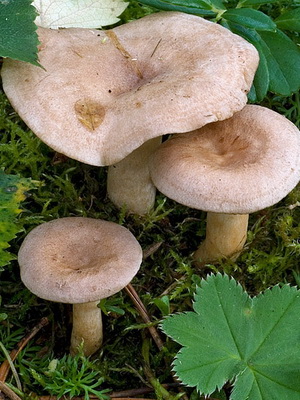
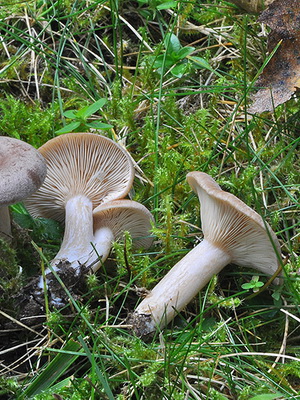
Fragrant Breasthead Hat (Lactarius glyciosmus) (diameter 4-8 cm): pale brown or beige, may fade to light yellow. Usually funnel-shaped, in a young fungus it is flat or even convex. Dry to the touch, with slight pubescence.
Leg (height 2-7 cm): the same color as the cap, smooth and loose, has a cylindrical shape. Older mushrooms are hollow.
Plates: frequent and thin, beige or flesh-colored.
Pulp: white, does not change color when cut or broken. Freshly cut mushroom smells like coconut.
Doubles:pale lactarius (Lactarius vietus) and teat (Lactarius mammosus). The faded one has a larger and more sticky cap, while the nipple cap is darker and with a pointed tubercle in the center.
When it grows: from early August to late September in the temperate zone of the Eurasian continent.
Where can I find: most often in deciduous forests, near birches and alders, among fallen and decaying leaves.
Eating: it goes well with other mushrooms when salted, although it is considered a mushroom of low quality, therefore it belongs to conditionally edible.
Application in traditional medicine: does not apply.
Other names: aromatic lactarius, coconut milkman, fragrant milkman, malt, fragrant milkman.










